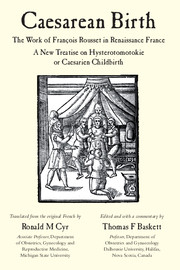 Caesarean Birth
Caesarean Birth Book contents
- Frontmatter
- Contents
- Acknowledgements
- Preface
- Translator's introduction
- François Rousset and the first text on caesarean section: a commentary by Thomas F Baskett
- A New Treatise on Hysterotomotokie or Caesarien Childbirth
- Sonnet
- Dedication
- Preface to the reader
- Part 1 Definition of caesarean childbirth
- Part 2 Second proof: logic (reason)
- Part 3 Third justification: expert opinion
- Part 4 Examples documenting other worse dangers from similar operations that are not caesarean
- Part 5 Other more popular justifications
- Part 6 On the fertility that remains after caesarean section
- A short guide to surgeons on the technique of caesarean
- Approbation
- Copyright
- Appendix 1 Summary of 16th century French history
- Appendix 2 Renée de France (1510–1575), Duchess of Ferrara, Chartres, Montargis and Nemours
- Appendix 3 Jacques de Savoie-Nemours (1531–1585), Duc de Nemours and Genevois
- Index
Preface to the reader
Published online by Cambridge University Press: 05 June 2014
- Frontmatter
- Contents
- Acknowledgements
- Preface
- Translator's introduction
- François Rousset and the first text on caesarean section: a commentary by Thomas F Baskett
- A New Treatise on Hysterotomotokie or Caesarien Childbirth
- Sonnet
- Dedication
- Preface to the reader
- Part 1 Definition of caesarean childbirth
- Part 2 Second proof: logic (reason)
- Part 3 Third justification: expert opinion
- Part 4 Examples documenting other worse dangers from similar operations that are not caesarean
- Part 5 Other more popular justifications
- Part 6 On the fertility that remains after caesarean section
- A short guide to surgeons on the technique of caesarean
- Approbation
- Copyright
- Appendix 1 Summary of 16th century French history
- Appendix 2 Renée de France (1510–1575), Duchess of Ferrara, Chartres, Montargis and Nemours
- Appendix 3 Jacques de Savoie-Nemours (1531–1585), Duc de Nemours and Genevois
- Index
Summary
At first, dear reader, I had intended to write only a simple case history, and relate some of the good–natured debates that Monsieur Paré and I have engaged in concerning the method of childbirth that I have dubbed ‘Caesarean’ and this in the French language that he has of late used more often during his conferences and in his writings. Believing that I had convinced him, by logic and the veracity of my case reports, that the Caesarean is indeed possible, I then resolved to write nothing at all.
The fact that other learned and distinguished persons have since replaced Paré as even more vociferous critics of the Caesarean section, has again compelled me—so that such a useful technique not perish, either from fear or neglect—to take up a defence of this subject, and delve even more deeply into related topics. To this end, I have written a more detailed treatise than I had earlier intended, and this in Latin: partly in deference to the status of my critics, but also to obey the wishes of the late Madame Renée de France, Duchess of Ferrara, who, shortly before her death, had asked me to do this, so that this technique should become known in foreign countries, and particularly to the Italian women of Ferrara. I believe that the private reading of this manuscript has already convinced most of my detractors, and I am considering publishing a summary for the public, this subject being essential, not only to surgery and medicine, but to all of mankind.
- Type
- Chapter
- Information
- Caesarean BirthThe Work of François Rousset in Renaissance France - A New Treatise on Hysterotomotokie or Caesarian Childbirth, pp. 25 - 28Publisher: Cambridge University PressPrint publication year: 2010


